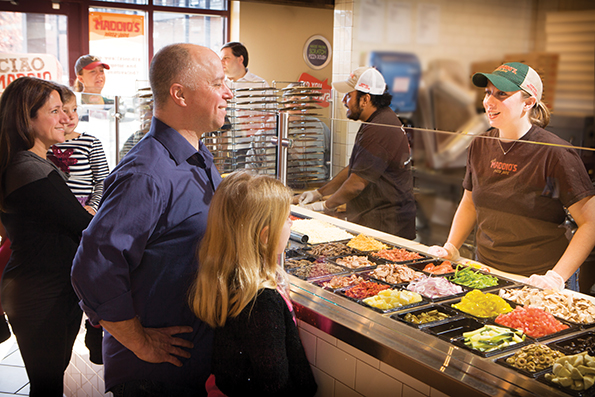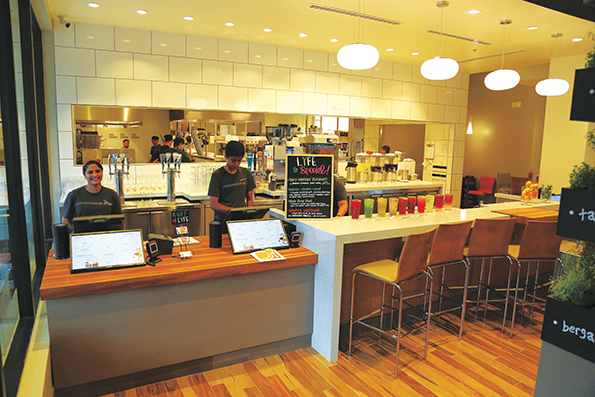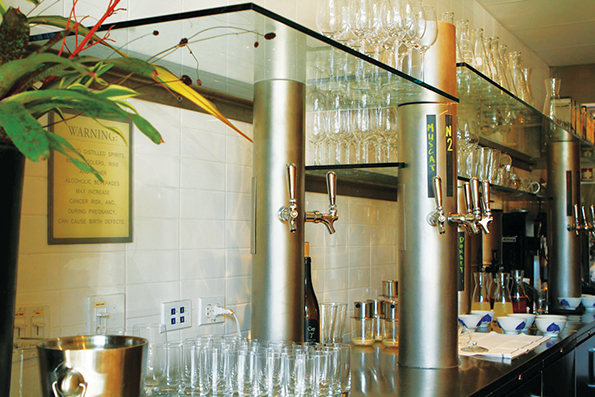No matter the sector of the restaurant industry, pacing in the kitchen is imperative. Fast-casual and quick-service concepts have to embrace the cook-to-order model as customers demand more customization, and casual-dining brands need to focus on speed during lunch, as well as varying customer demands during dinnertime.
Furthermore, younger customers are looking not just to spend their time and money at restaurants with great food, but also with brands that show a commitment to the environment, offer authentically pleasing designs that inspire a sense of trust and confidence in the creation of fresh, and safely prepared foods.
It’s no surprise then that the biggest trends in kitchen equipment have addressed these demands for speed, safety and sustainability.
A need for speed
Continuing developments in combi ovens and programmability — with storable variables in hot-air impingement, temperature, time, and moisture — many cooking procedures can be reduced to touch-panel presses. Combining steam and convection cooking, combi ovens can duplicate just about any cooking procedure while shaving off up to half the time, said Eli Forman, foodservice kitchen designer at Smith and Greene in Seattle. He noted that many fried chicken chains have adopted combi ovens to replace deep frying. First seen in European commercial kitchens, which tend to be smaller, they’re now found in most new restaurant construction and most culinary schools, he said. Fryers are also working faster through quicker recovery times, Forman noted, allowing cooks to throw in one frozen batch after another.
Other kinds of rapid-cook ovens have also found their way into more American restaurant kitchens. They have brought custom pizzas within range of abbreviated lunch hours, and other items like pastries are now able to be completed in minutes. In one Seattle property owned by James Beard Award-winning chef and restaurateur Tom Douglas, famous for its pot pies, a ventless fast-baking oven browns the pie through convection and is then warmed via the microwave.

“You wind up with a nice crust and you can cook it in eight minutes from frozen to fully ready to serve,” said Sean Hartley, director of operations. Certain Tom Douglas restaurants also have combi steam-and-convection ovens, which quickly bake, among other things, the croissants and pastries for the Starbucks Reserve Roastery & Tasting Room, which opened in December near Tom Douglas’ Serious Pie pizza restaurant.
The fast-casual pizza chain Uncle Maddio’s Pizza Joint makes use of a conveyor oven that cooks thin-crust, crispy New York-style pizzas quickly. From order-to-preparation and cooking-to-table, the pizzas are completed in seven minutes. The cook time alone is six minutes of that time frame.
“We do 200 pizzas an hour per store with two stacked ovens; a third can be stacked atop our standard two to bring capacity up another 100 pies per hour,” said Matt Andrew, CEO and founder. The ovens also “sear” the pizza as it progresses through the conveyor, and cooks them on the top and bottom at the same time.
Atlanta-based Uncle Maddio’s, which has more than 50 locations, also boasts a custom-made pizza-making table that houses and displays 46 different toppings.
The line is used by customers to custom order their pies, in a Chipotle-style service.
“That plays a very important role in delivering the speed to our customers and keeping the product fresh,” Andrew said. “It uses a liquid gel cooling system that’s above the table so our ingredients sit up high where customers can easily see them. It makes a great visual presence.
“Since it’s all in one table,” he continued, “it’s very efficient for our makers to get [the pizzas] into the oven quickly.”
Shell Hall, operations director at a 10-unit Whataburger franchisee, reports that the chain’s new toaster toasts a bun in 28 seconds, compared to a standard commercial toaster, which takes 50 to 65 seconds. Equally important, the new device toasts the underside of the crown, or top, and the upper side of the lid, or bottom, of a hamburger bun. The process provides crispness just where it’s wanted — rather than on both sides of each piece — and saves heat, thereby prolonging the life of the device as well as saving energy.
Big data in kitchens
The notion of big data has arrived at restaurant kitchens, too, where digital intelligence is gathered from the equipment itself or downloaded from online systems. This data is used to automate cooking sequences or optimize operations.
At LYFE Kitchen, a conveyor “precision impingement” oven installed in 2014 cooks a pizza in half the time of a traditional model, as well as all other types of dishes for the 15-unit chain.
“We figured out the cook time, temperature and speed of every menu item, and for guys on the line, it’s just about pushing a button,” as far as actual cooking is concerned, said chief restaurant officer Larry Taylor.
“You can load it with something else on the other side. I can walk away and know that one product will come out and the next will go in,” he said.
Even more, the chain’s Chicago-based headquarters can load settings for new menu items on a file, email it to properties and unit-level operators then update the oven’s settings through its USB port. It shouldn’t be long before the oven’s USB port is replaced or augmented with wireless connectivity to remove the middle man.
Networked sensors and video cameras can also send data to intelligent third-party monitors. Whataburger’s Hall uses a remote video monitoring service to check on 10 different aspects of operations. One of them includes making sure employees wear gloves. The service snaps ten pictures per audit for the restaurant operation, and also lets him log into the cloud-based system to view live video feeds or recorded video.
Designing for the brand
Open kitchens are popular in nearly all new concepts looking to display the freshness of their food.
At PDQ, the Tampa-based, nearly 30-unit fast-casual chicken tenders concept, the kitchen serves as the centerpiece of the loft-like, bright and open restaurant layout. The brand’s fresh-squeezed lemonade and hand-punched French fries are prominently displayed, with the lemonade at the front of the ordering line, and the potatoes prepared in the back fully visible to customers.
With its limited menu and its brand focus on fresh food and preparation, PDQ doesn’t need freezers in the kitchen.
The restaurant’s design includes one very unique element — a stainless steel round wash fountain with foot controls, which proves to be popular with children and families.
At Project Pie, another fast-casual pizza chain, the CEO says design trends need to stay true to the brand. “The new consumers can smell ‘BS’ a mile away,” said James Markham, who is also the concept’s founder. “You can’t build brand longevity that way.”

“New equipment can help,” he said, “but again, a restaurant has to think about how it ties to the DNA … and what you stand for.” He recommended choosing a color and ‘old-school’ look when choosing equipment. In Project Pie’s case, that means hand-glazed subway tiles, hand-scraped engineered hardwood floors, distressed wood tables, hand-painted lights made from recycled plumbing pipe, and art deco lighting fixtures. Markham’s vintage aesthetic goes onto the oven, as well, which is decorated with round penny tiles that are set in off-white grout. Furthermore, tin ceilings are used as wall coverings.
“People, especially Millennials, want to know the story: Where the food comes from and how it is prepared — the whole process,” Markham said.
“There is a way to tie the visual aesthetic into the brand,” Smith and Greene’s Forman said. Some equipment has a heavy steel look while others can be customized, and refrigeration is moving to under-counter units rather than reach-in units. It’s about the theater of food preparation.
Driving menu expansion
In many cases, the right piece of equipment multiplies a concept’s menu possibilities. Captain D’s Seafood Kitchen is about a year into its rollout of a new conveyorized, gas-fired broiler that adds grilled seafood, chicken and beef to its breaded, battered or sauced proteins. Jason Henderson, vice president of product innovation, said these new menu items now account for eight percent of sales.
The broilers are customized variations and burn gas, but also use infrared technology to keep idling temperatures at a scorching 750 degrees. This can cook thinner fillets and works well to char and bronze seafood, Henderson said.
Of course the biggest example of new equipment rollouts driving new menu items is the McDonald’s McCafe debut, which rolled out nearly five years ago. It was one of the largest undertakings in the chain’s history. The cost of equipment was debated with franchisees as expensive espresso machines were part of the plans, and the rollout to domestic operations was difficult. Still, the chain is partially counting on coffee to drive sales during a time of poor performance, especially in the United States.
According to reports, new marketing campaigns focused on breakfast and specialty beverages will be part of the plan this year at McDonald’s. Bloomberg reported that a new slogan, “Make the most of breakfast with McCafe,” and new images of red coffee beans will promote the beverages.
At the same time, coffee giant Starbucks is looking to expand its food offerings. Last month, the company named Stefano Cordova, a veteran of restaurant chain research and development, to the role of vice president of its evenings and food business development category. He will be responsible for supporting the growth of Starbucks’ food program during the breakfast, lunch and evening dayparts, as part of Starbucks five-year plan to double food sales in the U.S. to more than $4 billion.
Going green
The right equipment can help raise a restaurant’s profile when it comes to energy consumption, pollution or consumables. Today’s customers want to see a smaller footprint than in the past.
Realizing that half of the restaurant chain’s business was dine-in, Captain D’s decided to make a business case for permanent dishware. The ware washer chosen was an under-the-counter model that saves energy by filling with cold water. An internal heater brings the water up to washing temperature.
“Not having to upsize the facilities’ own hot water system can save a lot of money, especially on a retrofit,” Henderson said. The washer also automatically performs deliming. Its drain can pump out water up to 24 inches high, a flexibility that can also save serious money in a retrofit.
Captain D’s ware washer recycles steam that is created in the washing cycle to help power its internal heater. This also prevents employees from releasing steam plumes into the kitchen every time they open the unit door, which helps lighten the load on air conditioning use and prevents mold — a risk factor that is coming under increasingly strict health codes.

LYFE Kitchen has adopted a new keg system for wine sales by the glass. The storage and dispensing system does away with bottles, corks and labels, lowering cost, waste and environmental impact. A layer of nitrogen and CO2 gas covers the wine in the stainless steel kegs, preventing oxidation. According to Taylor, LYFE Kitchen can charge 30 percent less and make the same per-glass profit as they do from bottled wine, helping to drive trial and quantity of orders.
A very traditional piece of kitchen equipment — the broiler — has also evolved, according to Richard Young, education director at the Food Service Technology Center. New broilers use less energy for the same cooking results as radiant heat technology. Replacing open flames allows commercial grills to be lidded, trapping more heat inside for 25-percent less BTUs.
Equipment smarts and sustainability go together. Installed and monitored by third parties, web-enabled sensors and thermostats can measure energy costs, prevent food spoilage and enforce best practices. Au Bon Pain has piloted a system in several of its restaurants that reports usage by property — even down to the device. Au Bon Pain monitors usage of ovens, toasters, holding cabinets, steam tables, refrigerated prep tables, display cases, walk-in coolers, walk-in freezers, exhaust hoods, heating equipment and air conditioning. Data is always accessible through mobile apps or web interface.
The system also actively alerts operators if temperature or power consumption goes over set thresholds. David Liguori, vice president of supply chain, said Au Bon Pain has been able to reduce energy usage by remotely and centrally programming thermostats with a best-practice schedule optimized for both guest comfort and energy savings. The system also reports back to managers when energy-intensive equipment is turned on too early or left on too late.
“We have found that though many cafés previously had ‘programmable’ thermostats, their schedules were not always optimized,” he said.
Liguori reports that the chain projects annual electricity savings of around 10 percent per restaurant on average.
“We have also saved money on equipment service calls by reducing the number that become emergencies, and better directing technicians to the root cause of problems, rather than needing them to diagnose on-site, has eliminated potential return trips,” he said.
Safety first
Where equipment is concerned, food safety improvements mostly follow incremental advances in refrigeration and sanitation.
Food safety also benefits from monitoring services that alert operators to freezer or cooler malfunction. Au Bon Pain’s Liguori said a new system for the chain “alerted us that a refrigerated prep table at one of our cafes broke early one morning.” The data also revealed that the initial repair failed almost immediately, giving the operator the means to hold the vendor accountable and get manufacturers or technicians to the restaurants.
At Arby’s, service and sensors are going into all 860 company-owned restaurants to keep HVAC costs under control, as well as spotlight problems with rooftop cooling units and refrigeration equipment.
While smart equipment will help, food safety is reliant on the human element. Most tainted ingredients leading to food-borne illnesses are based on human error. And occurrences can happen to restaurants at any time.
“It’s not if, but when,” said Eric Martin, director of food safety at Texas Roadhouse, while speaking the Food Safety Symposium, an event sponsored by Ecolab and produced by Nation’s Restaurant News. “It’s an anxiety attack.”
Martin suggests restaurant chains and foodservice providers identify and train first responders at the unit level, have access to the best tools to handle cleaning and disinfection, have a professional response team on speed dial, and use social or other online data to stay alert to health department chatter on outbreaks.
Sarah E. Lockyer contributed to this report.

